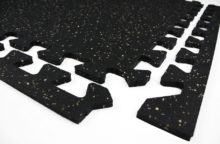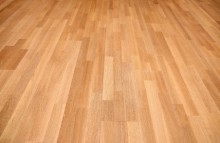Shop Flooring Choices
Article - September 24, 2012
First off, I need to say “thank you” to the woodworking community. When I was considering rubber floor tiles for the shop, the outpouring of opinions and suggestions was staggering! Getting advice online is always a crap shoot since we all have different tastes, needs, and regional conditions. But even with that in mind, the comments gave me serious food for thought on what was truly important for my shop floor, and what might be too risky.
Now the one thing I can’t stress enough is that THERE IS NO PERFECT FLOORING SOLUTION! Every option has at least one or two major flaws or questionable characteristics. This is exactly why I went in mental circles for weeks on this decision. So let me cut to the chase here: the flooring I found the least number of issues with was epoxy plus rubber mats in specific zones. Many of you suggested this very thing and in fact, I think it was the most popular suggestion.
Here’s a rundown of the options I considered and why I decided against them. There are two things you should keep in mind if you are using this article to help in your own flooring decisions (or if you plan to give me crap about mine, haha). First, I live in the desert. The dry climate here means that water just isn’t an issue, although we do have a few months of high humidity at the end of summer. Second, there is a lot of room for personal taste. Appearance was a major factor in my choice and of course, we can’t all agree on what looks good. I will try to make sure my opinions are clearly labeled as such.
Rubber Floor Tiles
 I broke this option down thoroughly in a previous article, so check that out if you’re interested. There are a number of reasons I didn’t go with rubber flooring. First is the appearance. It became clear to me that I definitely did not want to take any risks concerning the look of the floor. I really have no idea how much impact black flooring would have on light reflection, and consequently, video quality. Light colored tiles are available, but they cost about twice as much as the black/gray tiles and I really didn’t want to spend that much money.
I broke this option down thoroughly in a previous article, so check that out if you’re interested. There are a number of reasons I didn’t go with rubber flooring. First is the appearance. It became clear to me that I definitely did not want to take any risks concerning the look of the floor. I really have no idea how much impact black flooring would have on light reflection, and consequently, video quality. Light colored tiles are available, but they cost about twice as much as the black/gray tiles and I really didn’t want to spend that much money.
Another factor was the installation. Those tiles are incredibly heavy and I’m going to have my hands full just getting my tools in place, tuned up, and working. I really didn’t want to lose a week just for flooring installation.
The final factor was something I can thank many of you for, and that’s the ‘unknown’. Many of you brought up some great points about tool mobility, workbench stability, solvent reactivity, off-gassing, lighting, etc. All of these things made me realize that this was going to be a very expensive experiment. My gut (and the rubber flooring company), tells me everything probably would have been fine, but at this point in the game, I am not willing to do anything that has even a remotely questionable outcome.
Vinyl
 This one was a bit of a long-shot but I did consider it. I had one flooring company come out to give me a price on engineered hardwood, and after hearing my story, the salesman suggested vinyl flooring. He showed me some samples of this nice fiberglass (I think) material that not only looked decent, but had a little cushion to it. This was something I hadn’t even considered before but I was intrigued, so I had him price it out. Now, this could very well be a fluke, but the price was well over $10,000!! And this was a well-known major flooring installer in our area. In addition to the sticker shock, I heard some feedback from folks who mentioned that seams could eventually become an issue with this type of flooring in a high heat environment. With 12′ rolls, we would have three long seams in the shop. So vinyl was out.
This one was a bit of a long-shot but I did consider it. I had one flooring company come out to give me a price on engineered hardwood, and after hearing my story, the salesman suggested vinyl flooring. He showed me some samples of this nice fiberglass (I think) material that not only looked decent, but had a little cushion to it. This was something I hadn’t even considered before but I was intrigued, so I had him price it out. Now, this could very well be a fluke, but the price was well over $10,000!! And this was a well-known major flooring installer in our area. In addition to the sticker shock, I heard some feedback from folks who mentioned that seams could eventually become an issue with this type of flooring in a high heat environment. With 12′ rolls, we would have three long seams in the shop. So vinyl was out.
Solid/Engineered Hardwood
 Generally speaking, solid wood in an occasionally-conditioned work space is just a bad idea. As we all know, wood likes to move. My shop will experience seasonal and daily temperature swings as well and major humidity swings at the end of Summer, and as we are all well aware, this is not good for solid wood.
Generally speaking, solid wood in an occasionally-conditioned work space is just a bad idea. As we all know, wood likes to move. My shop will experience seasonal and daily temperature swings as well and major humidity swings at the end of Summer, and as we are all well aware, this is not good for solid wood.
Engineered hardwood is a little more realistic as it is essentially just fancy plywood. Even then, I had a few installers tell me they wouldn’t recommend this product for an inconsistently-conditioned space like the shop.
In both solid and engineered hardwood, cost was a major factor. If I chose to hire out the installation for the sake of saving time, the cost was just insane. So although this option would have been the nicest to look at, wood movement and cost knocked it out of the contest.
Laminate
I have installed several laminate (Pergo) floors over the years and while they are easy to install and nice to look at, they have a characteristic sound that is very unappealing to me (especially on High Heels Thursdays). Furthermore, a layer of dust on a laminate floor is a one-way trip to the broken coccyx doctor.
Sleepers and OSB or Ply
 I know many of you who have this type of floor in your shop and love it. We even posted a guest article on the topic. But there were a few reasons I dismissed it. First, I had serious reservations about popping holes in my brand new concrete slab. I realize a floor like this is supposed to be permanent, but something about that just bugged me. Also, I can be a little lazy, especially when I’m in a rush to get back to woodworking. 1800 sq feet is a LOT of real estate to cover!! And speaking of real estate, the thought of re-sale value did cross my mind. I know it’s crazy to think about that at this stage of the game, but I do like to think ahead. That’s exactly why I had them install a garage door header that I will never use. If I do sell this place one day, it’s a lot more likely to find a “car guy/gal” than a “wood guy/gal”. And a plywood floor probably wouldn’t be very appealing to potential buyers.
I know many of you who have this type of floor in your shop and love it. We even posted a guest article on the topic. But there were a few reasons I dismissed it. First, I had serious reservations about popping holes in my brand new concrete slab. I realize a floor like this is supposed to be permanent, but something about that just bugged me. Also, I can be a little lazy, especially when I’m in a rush to get back to woodworking. 1800 sq feet is a LOT of real estate to cover!! And speaking of real estate, the thought of re-sale value did cross my mind. I know it’s crazy to think about that at this stage of the game, but I do like to think ahead. That’s exactly why I had them install a garage door header that I will never use. If I do sell this place one day, it’s a lot more likely to find a “car guy/gal” than a “wood guy/gal”. And a plywood floor probably wouldn’t be very appealing to potential buyers.
Epoxy + Rubber Mats
 And now for the big winner. The decision on this came after a visit to my parents house. They have a small one-car garage with an epoxy coated floor. They only have a few fluorescent lights in the garage but whenever you turn them on, the space just looks bright and cheery. In my current garage, I have a crap-ton of light but I just don’t get the same effect from unfinished concrete. So epoxy wins major points for appearance.
And now for the big winner. The decision on this came after a visit to my parents house. They have a small one-car garage with an epoxy coated floor. They only have a few fluorescent lights in the garage but whenever you turn them on, the space just looks bright and cheery. In my current garage, I have a crap-ton of light but I just don’t get the same effect from unfinished concrete. So epoxy wins major points for appearance.
I discussed re-sale value above and an epoxy floor is a no-brainer in that area. Just about anyone would prefer an epoxy floor over an unfinished concrete floor.
There is no doubting the durability and protective qualities of epoxy. Professionally installed with high-grade materials, these floors last a long time and I’m sure it will stand up to just about anything I can dish out.
Cost was quite reasonable, coming out to about $2.40 installed. This included non-slip grit and those little flakes they like to apply.
The one area where epoxy fails miserably is comfort. Obviously, it does nothing to soothe my weary bones. So that’s where the rubber mats come in. Just like in the old shop, I’ll use rubber mats around the various tool zones. Perhaps I’ll even do an entire area where I know there will be heavy traffic. This way I can pick up the pads if and when I need to move the tools.
The one caveat here is that I am pretty much done with the cheap interlocking pads from the big box store. They are way too light and flimsy and I would like a more “semi-permanent” placement. So this brings me back full-circle to the rubber flooring company. Their mats are thick, heavy, and aren’t likely to move when vacuumed.
So once again, I appreciate the feedback from everyone. I am sure that many of you may disagree with my decision or even my logic. But that’s OK. If we all agreed unanimously on anything, that would be spooky. I hope my explanations and ramblings help you in your own shop flooring adventures.



